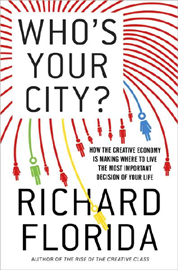Who's Your City?
 |
|
| Author | Richard Florida |
|---|---|
| Subject | Environmental psychology, Creative class |
| Genre | Non-fiction |
| Publisher | Basic Books, Random House |
|
Publication date
|
March 2008 |
| Media type | |
| Pages | 374 |
| ISBN | |
| OCLC | 316823460 |
| 304.2/3 22 | |
| LC Class | GF21 .F56 2008 |
Who's Your City?: How the Creative Economy Is Making Where You Live the Most Important Decision of Your Life is a non-fiction book written by Richard Florida. The book advances Florida's previous work on the locational choices of people and businesses. He adds a dimension of environmental psychology by assigning psychological profiles to urban regions according to the dominant personality traits of the people who live there. For example, the New York metropolitan area and the ChiPitts area have the highest concentration in the United States of people whose dominant personality trait is neuroticism. The book ends with a ten step guide to choosing a location best suited to the reader's personality and life situation. Since the 2002 publication of The Rise of the Creative Class, Florida has enjoyed academic and commercial success in his study and promotion of the concept of a creative class, or a cohort of highly innovative, highly creative individuals who are sought after by businesses. Who's Your City?, Florida's fourth book on the subject, combines scholarly research with a lighthearted self-help tone. Some critics questioned the assumption that the target audience, those easily able to move, would consult the book for advice on moving, but also found the book provides a valuable insight into the impacts of locational choices on the urbanized world.
Economic geographer Richard Florida came to prominence when he popularized the concept of a creative class, or a subset of individuals whose work involves creativity and innovation. Florida's previous three books, The Rise of the Creative Class (2002), Cities and the Creative Class (2005), and The Flight of the Creative Class (2005), link the creative class with wealth generation and argue that the individuals in the creative class choose to locate in places with strong cultural and recreational activities, as well as an interesting nightlife. Cities that have offered those activities have attracted innovative people, and despite high land and labor costs, businesses have chosen to re-locate to those areas in order to access them. With the success of his creative class theories, Florida founded a consulting firm, called the Creative Class Group, to advise local governments and other organizations about how to attract creative and innovative people. Florida, a professor at Carnegie Mellon University's Heinz College in Pittsburgh until 2005, wrote his next book, Who's Your City?, after moving to George Mason University's School of Public Policy. By the time he agreed to move to the University of Toronto he was deemed an "academic pop star". Upon his arrival, he was personally greeted by the mayor of Toronto and the premier of Ontario. Articles in the National Post and Toronto Star heralded his move, an article appeared in the magazine Style at Home featuring his new house, and he was given a regular column in the Globe & Mail.
...
Wikipedia
